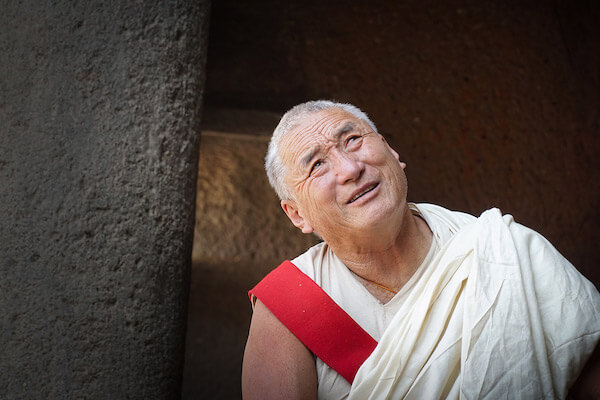“How to use meditation and work with emotions”
About meditation, thoughts and emotions …
Yes, many disturbing thoughts and emotions arise while meditating. However, that is not the key issue here, what is more important is the point of view you adopt about it. How do you want to see those negative, disturbing and strong thoughts when you practice meditation?
How do you work internally with emotions and thoughts?
There are two methods of dealing with so-called negative thoughts, emotions and disturbing thoughts when they arise in meditation.
The first method is to try to perceive them in the following way:
When they arise, instead of categorising or labelling them as bad, disturbing or negative, instead of trying to get rid of this feeling, sensation or emotion, take another stance. Whatever arises in meditation, do not try to suppress it, embrace it with compassion, with loving kindness. All these disturbing, even negative thoughts are also part of you. What appears during meditation is a part of your consciousness, it is not separate from you. It is not an appendage, it is a part of you.
So instead of rejecting them and suppressing them or externalising them by expressing them, it is better to embrace your thoughts, accept them, understand them. With love, with care, with gentleness, without judging them, without putting them in a category, without labelling them, as mother earth does. Everything on this earth – good or bad, medicine or poison, human or animal, shit or food – mother earth accepts it without expelling it, without throwing it away.
So, this is method number one. When some negative thought arises, don’t feel guilty, don’t try to get rid of it; instead give it space, embrace it, accept it, respect it, understand it, honour it. This is what this first method is all about.
If you apply this first method, the result will be much better than when you suppress, reject or try to get rid of so-called negative thoughts or disturbing emotions. If you can apply this in meditation, then in everyday life when the same kind of thoughts and feelings arise, you can also apply it.
Normally we act as if what we experience is not our own. We react as if it belongs to someone else. Sometimes we put it as if it is the parents, the husband, the children, the boss, it is all someone else’s fault. We see it as something bad; therefore it should not be our own.
This kind of mentality is a problem. All of that is you and belongs to you. If you think about the attitude of parents when they have their children, no matter how naughty or “ugly” the child is, the parents will not say “that is not my child”. Even if the child screams and yells at the parents, they won’t throw him out of the house. Instead, the parents embrace and accept him. Instead of hitting, they try to understand what the baby wants. Maybe the light is too bright, maybe the baby is cold, maybe the baby is hungry. Understand what the baby wants. That is the mentality with which you have to treat your emotions. They are your baby, so you don’t have to push them away, you have to accept them.
The second method is profound, and Mahamudra practitioners can apply it. You can say it is like space or like the wisdom of a mirror. Let the good thoughts, the bad thoughts, the positive and the negative, let everything arise without judging, without analysing, without labelling, without pushing or trying to get rid of anything. In this case you don’t even have to accept, honour and understand.
In this method there is no subject, no object as a subject needs to accept the object. It is like reflecting on the surface of a mirror. From the dualistic human point of view, it seems that there is a subject – the mirror – and an external object that is reflected. But from the mirror’s point of view, there is no subject and no object.
Therefore, in this method number two, from the point of view of the wisdom of the mirror – Dharmakaya – there is nothing ugly or beautiful, there is nothing good or bad, there is no right or wrong. These kinds of concepts do not exist.
So let everything be reflected, but without rejecting, pushing, labelling or judging.
If this example is not clear, then there is another example: it is like space. Space is unlimited, it is everywhere, but at the same time it is nowhere. The sun rises and the sun sets. The seasons of the year appear: summer, spring, autumn and winter; they all come and go. The same with the earth, the moon and all the stars. Space is always there without participating, without getting involved. Space
never thinks: “oh, it’s raining – I don’t like it; oh, thunder and it’s dark – I’m afraid; the day is bright – I’m happy, now I feel good”.
Space remains in equanimity. It was there from beginningless times and will be there until endless times. From the point of view of space there is no sky, sun or moon, no self as a separate thing. From the point of view of the human dualistic mind, one thinks: oh space is space, the moon is the moon, the sun is the sun, the earth is the earth. However, from the point of view of space, nothing is separate in this and that.
In that sense, limitless space is always in the state of non-duality. Again, the concept of duality and non-duality is given by humans. Non-duality is a natural state of every fruit. We give different names to non-duality. Mahamudra is non-duality, dharmakaya is non-duality, Dzogchen is non-duality, Buddha means non-duality, Buddha nature means non-duality, ultimate truth means non-duality, spiritual home means non-duality, awakening means non-duality. So, everything is included in non-duality.
Different names but one thing. Which means not to separate, to leave all things as they are. This is method number two, where you let any negative, disturbing emotion arise, but without putting it into a category, without labelling it as bad or good. You just let the feeling be. Not categorising, not pushing, not trying to get rid of anything.
Rang rig (Tib. རང་རིག) means, to be in a state of non-duality by themselves. This is very interesting. It means that when one goes deeper, without attending to the disturbing emotion by saying – “I am bad” – from the point of view of the emotion itself, it is essentially non-duality. Emotion itself is not separate from anything. It is we, ourselves who are giving the name “bad” and thus creating our own suffering. In this case Rang rig here represents that every emotion and thought has its own intelligence by itself to recognise itself in a state of non-duality by itself, in an awakened state. What arises is essentially non-duality itself; but by labelling from a third person’s perspective, we create the whole problem.
If you let them manifest as they are, everything has the essence of awakening as it is. So method number two is not to engage as a third person; just relax and let it arise. All thoughts will return to the state of spiritual truth, which is the state of awakening, non-duality. It is quite difficult.
I suggest that beginners apply method number one. Once they master it and can apply it, number one will lead them to method number two automatically.
If you jump straight to method number two, it can sometimes be too abstract and therefore difficult to grasp with the dualistic mind. So I suggest you use method number one in the beginning and you will be more compassionate with yourself, that is also important.
Love yourself, honour yourself, embrace yourself, your emotions, your negative thoughts, your regrets, it is nothing but yourself. So when you start loving them, embracing them, you will feel more comfortable with yourself. You will get much more space and love within you. The vibration of love within you will transform the people around you. Start sharing that inner love with your spouse, your children, colleagues and then include strangers. That is true compassion flowing outwards. Like a full bottle it naturally overflows. Once you start loving yourself, you will start loving more people.
When you forgive yourself, then bodhichitta will automatically reactivate. Because if you don’t accept your own emotions, if you don’t accept your own negative thoughts; if you reject them, if you expel them, if you deny them; there will always be a war within you. No matter how much you pretend to be a good human being on the outside, if you try to smile and follow moral ethics, be kind to your parents and friends; inside there is a war. It’s only a matter of time before you hurt yourself, before it breaks out on the outside with people close to you. Then people will be shocked: Oh, what the hell has happened to him?….. He was a good man or a good woman, what has he done?
It means he was just pretending! The madness …was repressed, hidden inside him. That’s why we call him “fake Bodhichitta” . To have a real Bodhichitta, you have to start loving and caring for yourself. Generate peace within and then automatically peace will spread outside. People will start enjoying your harmony and peace.
Once you get that, then it will be very easy to apply method number two because peace and tranquillity will be within. Good luck to everyone and please start to understand yourselves, honour yourselves and don’t fight with your emotions. Embrace them, honour them and understand them.



